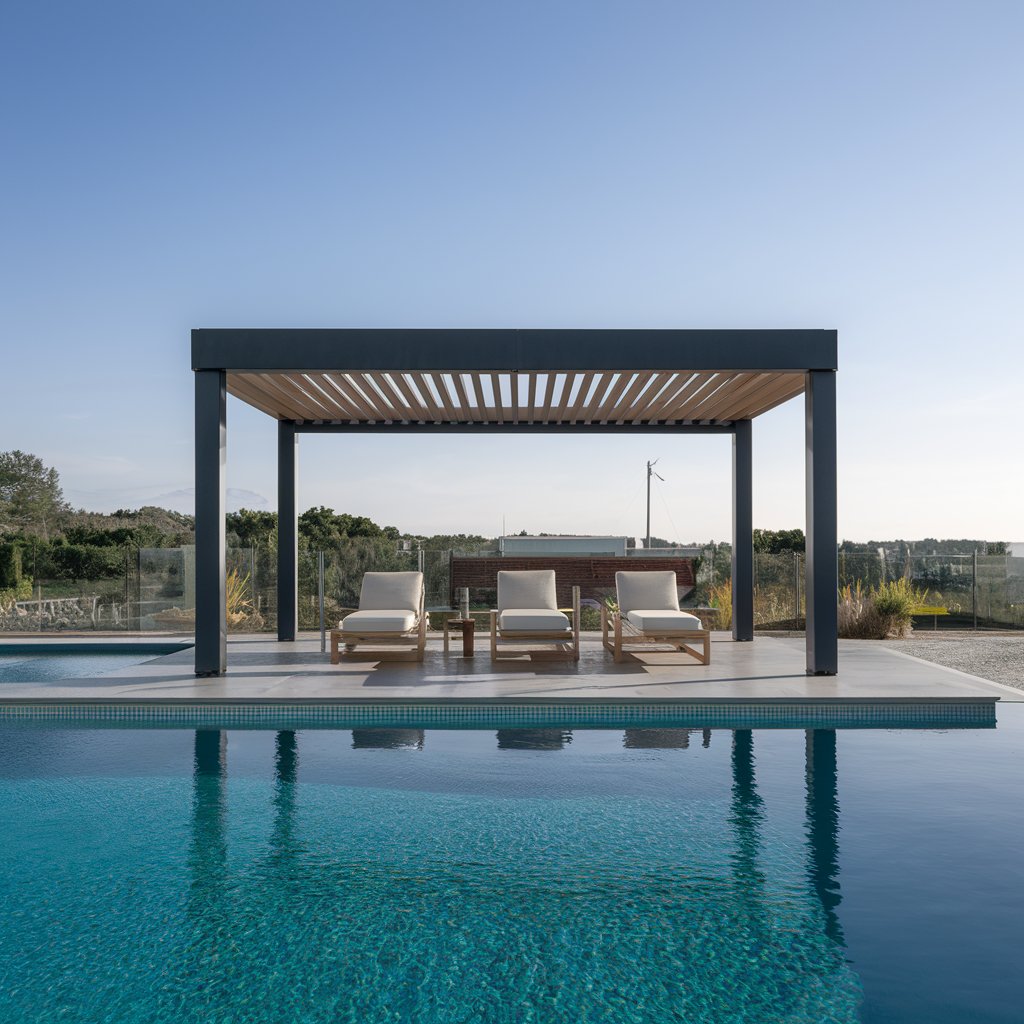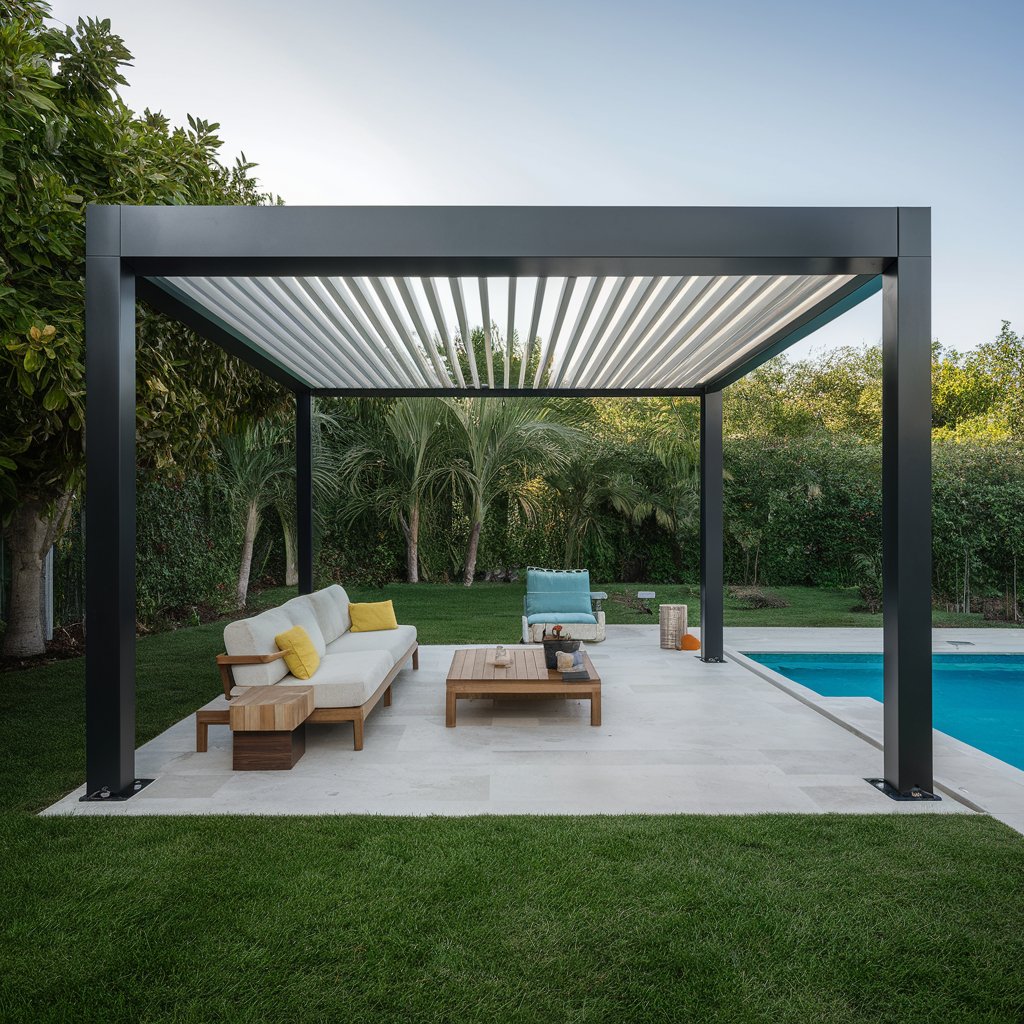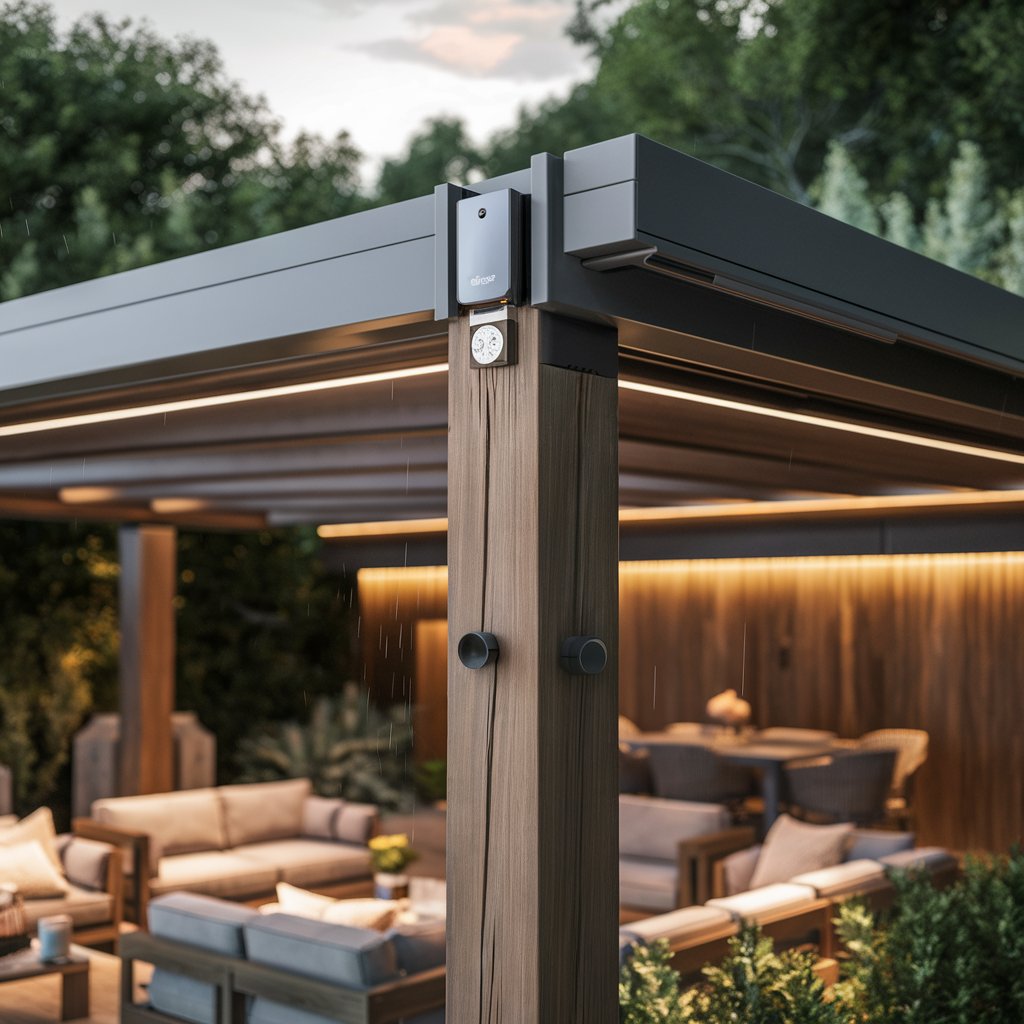A freestanding pergola is a versatile and attractive outdoor structure that can transform your garden or backyard into a functional and aesthetically pleasing space. Unlike attached pergolas, which are connected to a building, freestanding pergolas stand independently, offering greater flexibility in placement and design. This guide explores the benefits, materials, design considerations, and installation tips for freestanding pergolas, with a special focus on the use of aluminum.

1. Benefits of Freestanding Pergolas
Versatility in Placement Freestanding pergolas can be placed anywhere in your outdoor space, making them ideal for creating distinct areas for relaxation, dining, or entertainment. Whether positioned over a patio, by a pool, or in a garden, they offer a focal point and enhance the overall landscape design.
Architectural Interest These structures add architectural interest to your outdoor area. With various design options available, from classic to contemporary, a freestanding pergola can complement any garden style and serve as a statement piece.
Support for Climbing Plants Freestanding pergolas provide an excellent framework for climbing plants such as wisteria, roses, or grapevines. These plants can create natural shade and add a lush, green element to the structure, enhancing its beauty and providing a more intimate outdoor space.
Enhanced Outdoor Living By providing shade and a defined space, freestanding pergolas extend your living area outdoors. They can be outfitted with furniture, lighting, and accessories to create a comfortable and inviting environment for various activities.
Increased Property Value Adding a freestanding pergola can increase the value of your property. These structures enhance the visual appeal and functionality of your outdoor space, making your home more attractive to potential buyers.
Customizable Design Freestanding pergolas offer a high degree of customization. You can choose from various materials, colors, and designs to create a pergola that perfectly suits your taste and complements your outdoor décor.
2. Materials for Freestanding Pergolas
Freestanding pergolas can be constructed from various materials, each offering distinct advantages and aesthetic qualities.
Wood Wood is a traditional and popular choice for pergolas, offering a natural and rustic look. Common types of wood used include cedar, redwood, and pressure-treated pine. While wood pergolas are beautiful and can be stained or painted to match your outdoor decor, they require regular maintenance to prevent rot, warping, and insect damage.
Metal Metal pergolas, such as those made from steel or wrought iron, provide a modern and industrial look. They are durable and can support heavy climbing plants. However, metal pergolas may be prone to rust and require protective coatings or treatments to maintain their appearance.
Aluminum Aluminum is an increasingly popular material for freestanding pergolas due to its numerous benefits. Aluminum pergolas are lightweight, durable, and resistant to rust and corrosion, making them ideal for outdoor use. They require minimal maintenance and can be powder-coated in various colors to suit your design preferences.
3. Design Considerations for Freestanding Pergolas
When designing a freestanding pergola, several factors should be considered to ensure it meets your functional and aesthetic needs.
Size and Proportion The size of your pergola should be proportional to the available space and intended use. A larger pergola may be suitable for an expansive garden or patio, providing ample space for seating and dining areas. In contrast, a smaller pergola can create a cozy nook in a more compact outdoor space.
Shape and Style Freestanding pergolas come in various shapes and styles, including rectangular, square, circular, and even custom designs. The style of the pergola should complement your home’s architecture and the overall garden design. For example, a sleek, modern pergola with clean lines may suit a contemporary garden, while a more ornate design may be appropriate for a traditional or Mediterranean-style garden.
Roofing Options While pergolas traditionally have an open-roof design, various roofing options can be incorporated to provide additional shade and protection from the elements. These include retractable canopies, shade cloths, or solid roofs made from materials such as polycarbonate or metal.
Integration with Landscaping Consider how the pergola will integrate with your existing landscaping. Positioning it near garden beds, water features, or pathways can create a seamless flow and enhance the overall aesthetic of your outdoor space. Incorporating built-in planters or benches can also add functionality and visual interest.
Lighting and Accessories Incorporating lighting into your pergola design can extend its usability into the evening. String lights, lanterns, or built-in LED fixtures can create a warm and inviting atmosphere. Additionally, accessories such as curtains, outdoor rugs, and decorative elements can personalize your pergola and enhance its functionality.
Budget Considerations Budget is an important factor in the design process. The cost of materials, labor, and additional features such as lighting or roofing will impact your overall budget. Planning and prioritizing features can help you stay within budget while achieving your desired look and functionality.
4. Installation Tips for Freestanding Pergolas
Proper installation is crucial to ensure the stability and longevity of your freestanding pergola. Here are some key steps and tips for a successful installation:
Planning and Permits Before beginning the installation, check local building codes and regulations to determine if you need any permits. Planning the layout and design in detail will help ensure a smooth installation process.
Foundation and Anchoring A solid foundation is essential for a freestanding pergola. Depending on the size and weight of the structure, you may need to pour concrete footings or use ground anchors to secure the posts. Ensuring the posts are level and properly anchored will provide stability and prevent shifting over time.
Assembly Follow the manufacturer’s instructions carefully if using a pergola kit. If building a custom pergola, ensure all components are measured and cut accurately. Pre-drilling holes and using high-quality hardware will help ensure a sturdy assembly.
Finishing Touches Once the pergola is assembled, add any finishing touches such as staining, painting, or applying a protective sealant. Incorporate accessories like lighting, curtains, or climbing plants to personalize your pergola and enhance its functionality.
Safety Considerations During installation, prioritize safety by using proper tools and protective gear. If the pergola is large or complex, consider enlisting the help of a professional to ensure safe and accurate installation.
5. Maintenance of Freestanding Pergolas
To ensure your freestanding pergola remains in excellent condition and provides long-term enjoyment, regular maintenance is essential.
Wood Pergolas Wooden pergolas require more maintenance than other materials. Regularly inspect for signs of rot, insect damage, and weathering. Re-stain or paint as needed to protect the wood and maintain its appearance. Cleaning with a mild detergent and water can help remove dirt and mildew.
Metal Pergolas Metal pergolas, including those made from steel or wrought iron, should be inspected for rust and corrosion. Applying a rust-resistant primer and paint can help protect the metal. Regular cleaning with water and a mild detergent will keep the pergola looking its best.
Aluminum Pergolas Aluminum pergolas are low-maintenance and resistant to rust and corrosion. Simply clean with water and a mild detergent to remove dirt and debris. Inspect for any loose bolts or hardware and tighten as needed.
General Tips Regularly inspect all pergolas for any structural issues or damage. Ensure that climbing plants are not causing damage to the structure. Trim back any overgrown plants to maintain airflow and prevent excessive weight on the pergola.
6. Aluminum Freestanding Pergolas: A Detailed Look
Aluminum freestanding pergolas offer a blend of modern aesthetics, durability, and low maintenance. Here’s a closer look at the benefits and considerations of choosing aluminum for your pergola:
Durability and Weather Resistance Aluminum is highly resistant to rust and corrosion, making it an ideal material for outdoor structures. It can withstand harsh weather conditions, including rain, snow, and intense sunlight, without deteriorating.
Lightweight and Strong Aluminum is both lightweight and strong, providing structural stability without the bulk of heavier materials like wood or steel. This makes it easier to handle during installation and reduces the need for heavy-duty foundations.
Minimal Maintenance One of the key advantages of aluminum pergolas is their low maintenance requirements. Unlike wood, aluminum does not warp, rot, or require regular staining or painting. A simple cleaning routine is usually sufficient to keep it looking new.
Modern Aesthetic Aluminum pergolas have a sleek and contemporary look that can complement modern garden designs. They are available in various finishes and colors, allowing for customization to match your outdoor décor.
Eco-Friendly Option Aluminum is a recyclable material, making it an environmentally friendly choice for your pergola. Choosing aluminum supports sustainable practices and reduces the environmental impact of your outdoor project.
Cost Considerations While aluminum pergolas may have a higher initial cost compared to some other materials, their longevity and minimal maintenance can result in cost savings over time. Consider the long-term benefits when evaluating your budget.
7. Design Ideas for Aluminum Freestanding Pergolas
Aluminum freestanding pergolas can be customized in various ways to suit your personal style and functional needs. Here are some design ideas to inspire your project:
Modern Minimalism For a sleek and modern look, choose an aluminum pergola with clean lines and a monochromatic finish. Pair it with minimalist furniture and geometric planters for a contemporary outdoor space.
Classic Elegance Combine the durability of aluminum with classic design elements such as decorative columns or lattice panels. This can create a timeless look that blends well with traditional garden styles.
Integrated Lighting Incorporate built-in lighting fixtures into the pergola’s design to extend its usability into the evening. Options include string lights, recessed LED lights, or lanterns attached to the pergola’s beams.
Retractable Canopy Add a retractable canopy to your aluminum pergola for adjustable shade and protection from the elements. This feature allows you to enjoy the pergola in various weather conditions and provides flexibility in how you use the space.
Green Oasis Enhance the natural beauty of your pergola by training climbing plants such as jasmine, clematis, or ivy to grow along the beams. This creates a green canopy that provides shade and adds a lush, organic element to the structure.
Outdoor Kitchen Transform your pergola into an outdoor kitchen and dining area by incorporating a grill, countertops, and a dining table. Aluminum is a practical choice for this setup due to its resistance to heat and weather.
Relaxation Retreat Create a cozy retreat under your pergola with comfortable seating, outdoor rugs, and soft lighting. Adding elements like hammocks or swings can enhance the relaxation vibe and make the pergola a favorite spot for unwinding.
8. Installation Guide for Aluminum Freestanding Pergolas
Installing an aluminum freestanding pergola can be a rewarding DIY project or a job for professional installers. Here’s a step-by-step guide to help you through the process:
Step 1: Planning and Design Begin by planning the design and layout of your pergola. Consider the size, shape, and location within your outdoor space. Measure the area accurately and ensure there is enough clearance for the pergola’s height and width.
Step 2: Gather Materials and Tools Ensure you have all the necessary materials and tools for the installation. This includes aluminum beams and posts, connectors, screws, a level, a drill, and concrete for the footings.
Step 3: Prepare the Site Clear the installation site of any debris or vegetation. Mark the locations for the pergola posts using stakes and string to ensure proper alignment. Check for any underground utilities before digging.
Step 4: Install Footings Dig holes for the pergola posts according to the manufacturer’s specifications. Pour concrete into the holes to create solid footings. Allow the concrete to cure completely before proceeding.
Step 5: Assemble the Frame Assemble the aluminum beams and posts according to the pergola’s design. Use high-quality connectors and hardware to ensure a sturdy assembly. Pre-drill holes if necessary to prevent the aluminum from cracking.
Step 6: Secure the Posts Position the pergola posts over the footings and secure them in place using anchor bolts. Ensure the posts are level and plumb before tightening the bolts completely.
Step 7: Attach the Beams Attach the horizontal beams to the top of the posts, creating the pergola’s framework. Use a level to ensure the beams are straight and even. Secure the beams with appropriate hardware.
Step 8: Install Cross Beams and Accessories Add the cross beams or rafters to complete the pergola’s roof structure. These can be spaced evenly or in a pattern that suits your design. Attach any additional accessories, such as lighting fixtures or retractable canopies.
Step 9: Final Adjustments Check the entire structure for stability and make any necessary adjustments. Tighten all bolts and screws to ensure the pergola is secure. Clean up the installation site and dispose of any debris.
Step 10: Finishing Touches Add any finishing touches, such as painting or sealing the aluminum, if desired. Decorate the pergola with furniture, plants, and accessories to create your ideal outdoor space.
9. Maintenance Tips for Aluminum Pergolas
To keep your aluminum pergola looking its best and ensure its longevity, follow these maintenance tips:
Regular Cleaning Clean the pergola regularly with water and a mild detergent to remove dirt, dust, and debris. Rinse thoroughly to prevent soap residue from accumulating.
Inspect for Damage Periodically inspect the pergola for any signs of damage, such as loose bolts or connectors. Tighten or replace hardware as needed to maintain structural integrity.
Protective Coatings If your pergola has a powder-coated finish, ensure it remains intact. Touch up any chipped or scratched areas to prevent corrosion and maintain the pergola’s appearance.
Prevent Plant Overgrowth If you have climbing plants growing on the pergola, regularly trim them to prevent excessive weight and ensure proper airflow. This will help maintain the structural stability of the pergola.
Seasonal Maintenance Before the onset of extreme weather conditions, such as heavy snow or high winds, inspect the pergola and make any necessary repairs. Remove any removable accessories, such as canopies or curtains, to prevent damage.
10. Conclusion
A freestanding pergola is a versatile and attractive addition to any outdoor space. With various materials and design options available, you can create a structure that complements your garden and enhances your outdoor living experience. Aluminum pergolas, in particular, offer a durable and low-maintenance option that can withstand the elements and provide years of enjoyment. By considering size, style, and installation requirements, you can design and build a freestanding pergola that transforms your garden into a functional and beautiful oasis.
Aluminum freestanding pergolas offer a blend of modern aesthetics, durability, and minimal maintenance, making them an excellent choice for contemporary outdoor spaces. Whether you envision a sleek minimalist design, a classic elegant structure, or a functional outdoor kitchen, aluminum pergolas provide the flexibility and resilience needed to bring your vision to life. By following proper installation techniques and maintenance practices, you can enjoy your aluminum pergola for many years, creating countless memories in your beautifully enhanced outdoor space.
4o


